Going Mobile
How the mobile revolution changed the way we market and develop for the Web.
The Rise of Mobile Devices
In just a few short years, mobile devices like smartphones and tablets have completely changed the way we interact with the world, with our friends and family, and how we discover and retrieve information. The adoption rate of these smart mobile devices has been faster than any other form of personal technology.
We witnessed a similar transformation not too long ago, when all of sudden it seemed like everyone had an analogue mobile phone, and the ubiquitous landline seemed so archaic in comparison. When mobile phones first became mainstream, the very dynamic of the conversation changed to a location based one. “Hey, where are you?” became a normal way to open a discussion when calling someone. This forever changed the way we were able to communicate with each other.
It took the better part of a decade for these original mobile phones to start really migrating into our daily lives. It’s estimated that about 1 in 4 American homes don’t even have a landline at all, relying fully on their mobile devices for phone calls. That number would be certainly higher when looking at particular age demographics.
Mobile-broadband subscriptions have grown 45% annually over the last four years. Mobile-broadband subscriptions outnumber fixed broadband subscriptions 2:1. Pew Research Group says that one third of American adults own a smart phone now.
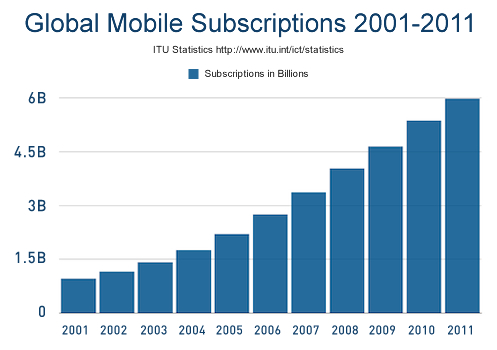
New smartphones aren’t just phones either. They are connected to the Internet and can access anything a desktop computer can. Studies show 25% of smartphone owners use their phone rather than a computer to go online.
Smartphones and tablets are replacing landlines, mobile phones, desktop computers, cameras, mp3 players, and just about any other personal technology device. They are even replacing books!
Currently, desktop computers generate 63% of all Web traffic, but according to Cisco, that number will decline to 46% by 2015.
How Mobile Devices are Used
The fundamental difference between desktop computers and smartphones starts with portability. With portability, comes the ability to satisfy a sense of urgency for our needs. The latest poll out of Google say that 89% of smartphone users use the device throughout the day, outside the home. Smartphones change the way we wait in line at the grocery store. Need to get some banking done while waiting to buy some milk? No problem. We are using mobile devices while shopping to compare prices on the fly, while at a party to instantly share photos with friends, at the doctor’s office, airport, and library. An astonishing 39% even admit to using a smartphone while in the bathroom.
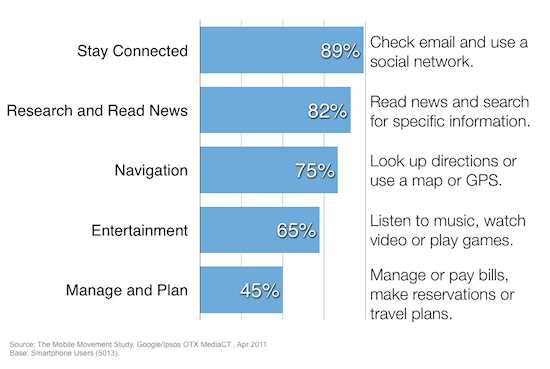
Mobile Devices and Internet Marketing
With the rise of the mobile internet, complex and exciting opportunities exist for marketers and technology developers. There are fundamental differences between someone browsing the Web on a desktop, and someone using their smartphone while on the go. Consumers are researching products and services while on the go, and can make informed decisions almost instantaneously. We can scan barcodes using the camera of our device to instantly find a better price, and then use our GPS location to find a nearby store selling it cheaper.
Smartphone users can instantly be connected to the closest plumber, glass repair shop, or restaurant by simply asking their device to find it for them and connect a call. Often a visit to the website is not even needed.
As marketers, the challenge is to keep up with the rapidly changing technology and consumer behavior.
Relentless Technology’s Owen Prior was recently interviewed by The Globe and Mail on mobile uses in marketing and technology. “The mobile visitor has a different goal in mind,” Mr. Prior says. “They want the address and phone number. Then, they’re gone.”
With the exponential growth of mobile, forward thinking marketers will make mobile the priority first, and traditional desktop computer second. The focus is a “Mobile First” strategy.
Is Your Website Mobile?
There are fundamental differences between a 4-inch monitor that is with you at all times, and a 27-inch flat screen monitor that sits in your living room. The first difference is the screen real estate, the second is the intent behind the visit to the website. Mobile users have different needs than a desktop user, and more importantly different capabilities.
As Internet marketers we strive to cater to both types of users. The obvious place to start is the website. When designing for mobile users, screen real estate and user intent is the basis for all design decisions. Typically we look at our analytics for historical use of the website. What are our mobile visitors doing and how can we serve them better?
An example of a website we recently completed is the website for SSMLaw, an employment law firm based in Toronto. We discovered that the intent of their visitors was not to consume content, so much as to send a very quick email, call, or find the office location. The solution was a very simple mobile design that gave these contact options first and foremost, with content consumption options available if needed.

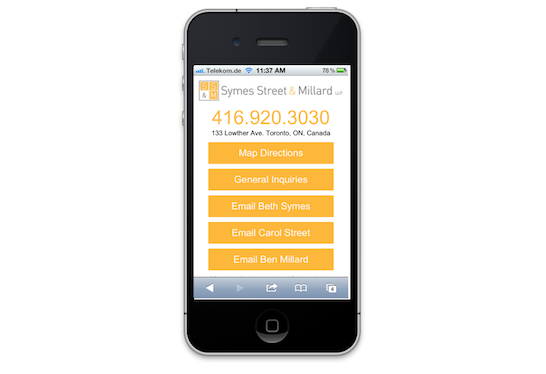
Search Marketing
Search marketing in a mobile world has also changed dramatically. Again, screen real estate and proximity have changed the rules to accommodate mobile consumers. The number of results per search page is much less, which puts more pressure on search marketing campaigns to achieve top positions. Plus as search results become more and more personalized based on each users own preferences, locations and connections, the search strategy becomes more complicated.
Searches visitors have the option of “tap to call” which instantly connects them to the business’ phone. This is dramatically different than a desktop search as the business’ website isn’t even involved at all in the contact. The search results also offer direction via the GPS map, again not even sending the user to the business website.
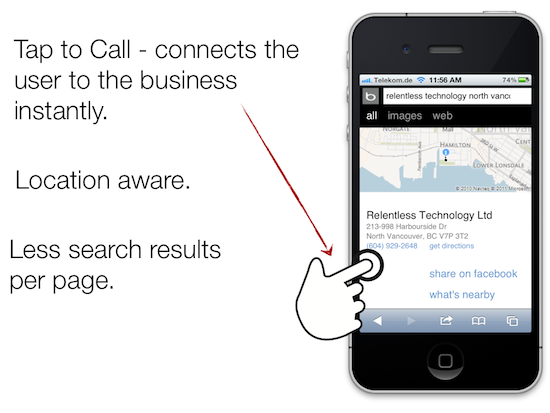
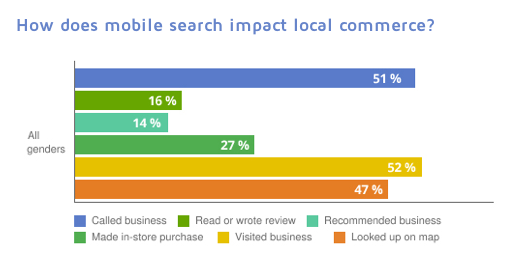
Paid Search Marketing
Paid search marketing is perhaps the most exciting marketing service we focus on at Relentless, simply because of the flexibility, reporting, and instant results. Mobile Adwords campaigns offer lead capture abilities not available with traditional desktops. For example, we can set up a campaign that is targeted to phones, and when our ads are seen on mobile devices, users can tap the phone number on the ad and instantly connect with our clients. The advertiser pays the same for the click to the website as they do a tap to call.
This is an important distinction to consider. With Adwords desktop, advertisers are charged when a user clicks on their ad which then brings the user to the website. This in itself is not yet a direct lead though, as the website still needs to be navigated and contact made through a form or email.
With Adwords mobile however, the advertiser could potentially pay the same amount for the user to tap the call that directly connects the user with the advertiser.
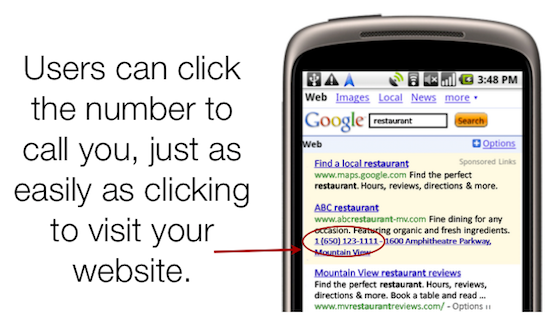
How You Can Take Advantage of Mobile
Making the move to a mobile first strategy starts with knowing what online assets you have in place, and then determining how those assets can be delivered across all device types. From there you need to understand the intent of mobile users for your particular website. Would your users need basic contact information like phone numbers and directions? Or would your visitors need to be able to make purchases through your mobile site?
If you are unsure of how to proceed, feel free to ask us. We have developed many different mobile campaigns for our clients and would love to help you get started.
Posted on: 02/14/2012
Posted by: Craig Hauptman – President & Founder
Related Insights:
Search Traffic: Paid vs. Organic – The Fundamental Differences and How to Leverage Each Type
Mobile Majority – Why a Mobile-First Approach is so Important
The AIDA Model – When to Use Specific Digital Ad Platforms Throughout the Sales Funnel
A/B Testing for Continual Improvements – Split Testing for Incremental Website Improvements
AI Chatbots & Search Engines – How AI Chatbots Will Impact Search Engines
















